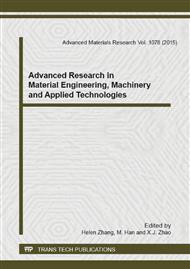p.49
p.53
p.57
p.61
p.65
p.70
p.74
p.78
p.82
Pull-In Behavior of Carbon Nanotubes in Networks
Abstract:
The pull-in behavior of carbon nanotubes (CNTs), which is the sudden increase in the deflection of two interacting CNTs, affects the properties of CNT networks significantly, and thus becomes an important subject in applications. In this paper, an energy-based analysis is carried out to predict the pull-in behavior as well as the critical pull-in distance between two interacting CNTs, and the results agree well with the subsequent atomistic simulations. Furthermore, the factors that affect the critical pull-in distance are also investigated. It is found that the length and diameter of CNTs and space angle between CNTs affect the critical pull-in distance significantly: the critical pull-in distance increases almost linearly with the increasing CNT length and decreasing CNT diameter, and the parallel CNTs have a much higher critical pull-in distance than the non-parallel CNTs. Besides, the chirality of CNTs has a little influence, and when the two CNTs are both zigzag and armchair, the critical pull-in distance is higher than the CNTs with other chiralities due to their stronger commensurability effect. The method and results in this paper will provide nanoscale reference for the design and optimization of CNT-based nanomaterials and nanodevices.
Info:
Periodical:
Pages:
65-69
Citation:
Online since:
December 2014
Authors:
Keywords:
Price:
Сopyright:
© 2015 Trans Tech Publications Ltd. All Rights Reserved
Share:
Citation:


